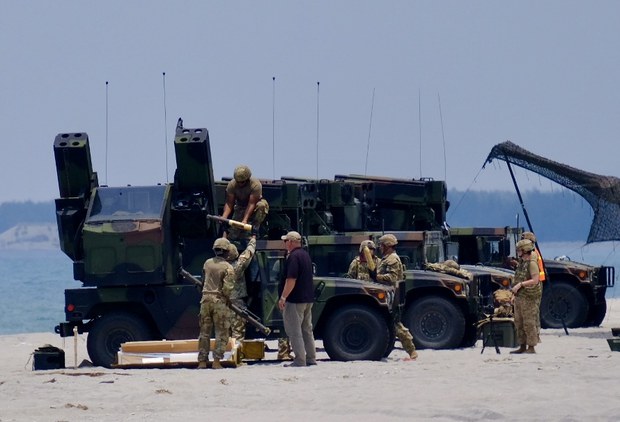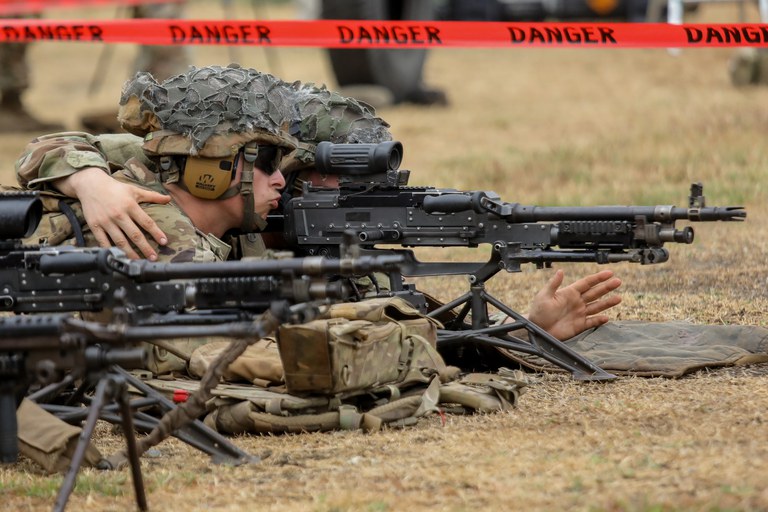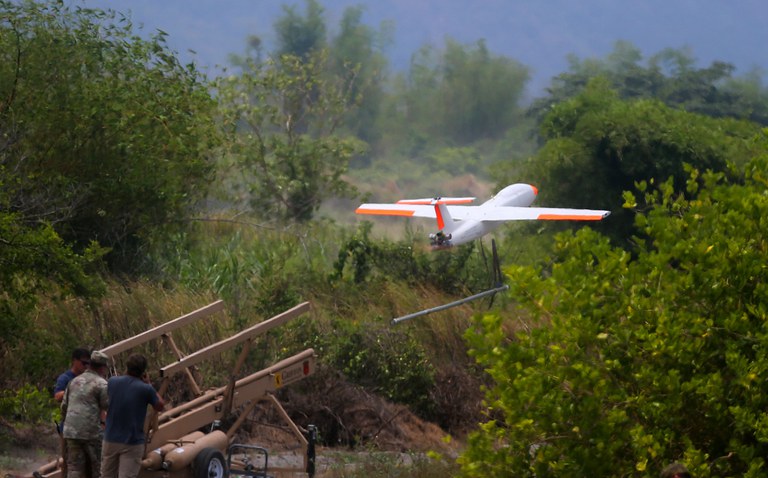Annual Balikatan Exercise with US will test new Philippine defense strategy
2024.04.04
Manila
 U.S. troops prepare to load a rockets during live fire exercises along the shoreline of San Antonio in Zambales province, northwest of the Philippines, during the Balikatan Exercise 2023, April 25, 2023.
U.S. troops prepare to load a rockets during live fire exercises along the shoreline of San Antonio in Zambales province, northwest of the Philippines, during the Balikatan Exercise 2023, April 25, 2023.
The upcoming annual large-scale joint military exercise between the Philippines and the U.S. will feature drills along the outer edge of South China Sea waters of Manila’s exclusive economic zone, officials said Thursday.
The Balikatan (shoulder-to-shoulder) Exercise 2024, to run from April 22 to May 18, will focus on testing the Philippines’ new Comprehensive Archipelagic Defense Concept (CDAC) announced by Defense Secretary Gilberto Teodoro Jr. earlier this year, they said.
The concept, rolled out amid heightened bilateral tensions in a territorial dispute with Beijing in the South China Sea, calls for incorporating all services of the armed forces, not only the navy, in defending Philippine waters, particularly its 200-mile exclusive economic zone (EEZ). Previously, the navy alone guarded the seas against an enemy force, while the coast guard acted as its civilian counterpart.
Col. Michael Logico, the Philippine Balikatan spokesman, noted this would be the first time that the exercise will be held up to the edge of the country’s territorial waters.
“We will go out of our 12 nautical miles of our territorial waters. We will exercise beyond that, up to the edge of our exclusive economic zone, 200 nautical miles,” Logico told Manila radio DZBB.
Ahead of Balikatan, the Philippines plans to hold joint naval drills with the United States, Japan and Australia in the South China Sea on Sunday, news service Agence France-Presse reported, based on information from diplomatic sources.
Following those drills, U.S. President Joe Biden is to host Philippine President Ferdinand Marcos Jr. and Japanese Prime Minister Fumio Kishida for an unprecedented three-way summit between the countries at the White House in Washington on April 11.
During their meeting, the leaders are expected to announce that their countries will launch trilateral patrols in the South China Sea, a move seen as a challenge by the allies to increased Chinese aggression in the waterway.
Last month, three Filipino crew members were injured when the China Coast Guard blasted their resupply boat with water cannons as it tried to deliver supplies to a Philippine military outpost in Second Thomas Shoal (Ayungin Shoal).

This year’s Balikatan is expected to draw at least 16,000 troops (11,000 from the U.S. and 5,000 from the Philippines). Organizers said it could be larger than the 2023 exercise, which set a record by drawing nearly 18,000 troops from the two countries, other participants and observer nations.
Military officers have said the Philippines and U.S., joined by Australia, would conduct artillery drills along with board, search and seizure exercises as part of a group sail in the West Philippine Sea during the early phase of the Balikatan. Filipinos refer to South China Sea waters within its EEZ as the West Philippine Sea.
The defense department said Australia and France were expected to be direct participants in the annual exercise, but did not announce the number of troops each country would be sending.
Fourteen countries, including Japan and Canada, are expected to send troops as observers as well.
“This Balikatan will be a showcase of our capabilities in performing our mandate in accordance with the Comprehensive Archipelagic Defense Concept, which was announced by our Department of National Defense,” Logico said.
“So that means that our exercises, our defense concepts have to go beyond 12 nautical miles in order for us to protect our national interests within our territory, within our territorial waters and also within the exclusive economic zone,” he said.
On the possibility that the Balikatan Exercise occurring outside the country’s 12 nautical miles territorial waters would increase tension with China, Logico said: “Well, that’s their problem, that’s not our problem.”
Earlier this week, a Chinese Foreign Ministry spokesman blamed the Philippines for regional tensions.
“[F]or some time, the Philippines has been pulling non-regional actors into the South China Sea affairs to back the Philippines’ provocations and violation of China’s sovereignty. The Philippines has been pursuing selfish gains at the expense of the consensus reached by countries in the region,” spokesman Wang Wenbin told reporters in Beijing on Wednesday. “This is the main reason why the situation in the South China Sea has escalated and become more complicated.”

Past Balikatan exercises have been focused inside military camps, including Fort Magsaysay in northern Nueva Ecija province, the Crow Valley in Pampanga province, as well as the Naval Education and Training Command in Zambales – all in the northern Philippines.
“We are very familiar with those areas, they offer no more surprises. So the only way for us to upscale or to upgrade our training is to start training in challenging areas, areas that we believe will provide the benefit for our soldiers and at the same time offer new challenges,” Logico said.
Taking defense ‘seriously’
Renato de Castro, a political analyst at the De La Salle University in Manila, said the new strategy was meant to address the maritime dispute with China. Adopting the new CDAC strategy “is a sign that we are finally taking our external defense seriously.”
“How many decades and administrations have passed where the attention has been focused on internal security operations,” de Castro said in a statement last month.
“But right now, the external security threat has emerged as the bigger challenge where they are intruding in our waters and getting our marine riches,” he said, referring to China.

He warned that if the government failed to put up a strong stand, “they will surely intrude in our inter-island waters.”
De Castro said that the adoption of the new security strategy went hand-in-hand with the armed forces’ modernization efforts. Part of the plan calls for acquiring marine assets, such as submarines.
“When we talk about comprehensive power, this really refers to the armed forces. So this means we would have to really strengthen our maritime and air capabilities, and of course develop other services of the Armed Forces of the Philippines,” de Castro said.







